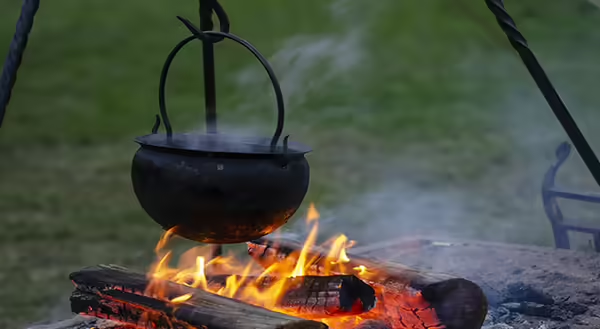
Thanks to 4-H Memorial Camp in Monticello for hosting Illinois Extension and Monticello Elementary School for a day of education about pioneer lifestyle, including choosing items for a covered wagon journey, playing games, cooking and preserving foods, and learning about pelts and animals.
The food portion of the day included a talk about how to cook when electricity and modern equipment were not available, such as campfire cooking. While this lesson was short and simple for the elementary students, let’s get a little more in-depth here.
What Temperature Does a Campfire Reach?
Looking at flame color can help determine fire temperature. White flames are very hot. Red or orange flames are cooler heat. Blue flames have a temperature in between white and red-orange flames.
While there are techniques to cook directly on coals, most campfire cooking cooks food with the heat coming off the flames. That heat can reach around 600°F (320°C).
Regulate Campfire Cooking Temperatures
Moving your cooking equipment further away lowers the heat reaching the food. "Further away" could mean raising the cooking equipment upward, away from the flame. It could also mean moving the food off the flame and using indirect heat, which will be cooler.
Moving everything closer to the flames increases the cooking temperature. Adding a small amount of extra firewood helps to slowly increase the heat. Avoid adding too much firewood all at once, which can raise the temperature too much. Remember, the goal is a campfire for cooking, not a bonfire.
Keeping a Fire Going
Read the Campfires article from the National Park Service for tips on starting and regulating fires. Also check out the References list at the end of this post for more helpful information, such as types of wood that work well in campfires.
Helpful Equipment
Outdoor cooking is its own section of the outdoor equipment world. With all equipment, learn how to use it in order to be safe.
A basic cooking surface could be aluminum foil. (Though, be careful your campfire is not hotter than 1200°F, where aluminum starts to melt. Remember, no bonfires!) Cast iron, including skillets and dutch ovens, is a popular cooking surface with its even cooking ability. Grill grates and tripods hold up skillets and pans above the heat.
For safety, remember equipment like tongs and hot pads, and use probe thermometers to check food temperatures. Keep water nearby to put out fires that get too big.
A Few Outdoor Cooking Tips
- Avoid cooking on a newly started fire. Let the firewood heat until some has broken down into coals. This can provide a more regulated heat.
- Prepare all your ingredients before starting cooking. While the fire is heating and stabilizing, this is a great time to chop. Of course, practice food safety skills throughout the cooking process.
- Provide a barrier between your food and the flames, such as foil or a skillet. Food is more likely to burn, than cook into something you want to eat, when exposed to direct flames.
- For cooking surfaces with lids, such as dutch ovens, consider covering the lid with coals to add heat on top.
Recipes
Check out books from your local library, read recipes that come with your outdoor cooking equipment, and search online for recipe ideas, including Backcountry Campfire Recipes from Iowa State University.
Have patience with building the fire and cooking over it. Outdoor cooking is part science and part art. It takes practice.
References:
- Burke B. Kitchn. What Are the Rules of Cooking Over a Fire Pit? 2017.
- Haines B. GudGear. How Hot is a Campfire? [Chef’s Guide to Campfire Cooking]. 2019.
- Jackson J. Outside. How to Cook Over a Fire. 2018.
- National Park Service. Cooking in Camp. 2019.
- Outdoor Life. 3 Easy Ways to Cook over an Open Fire. 2019.
- Splawn M. Kitchn. 5 Rookie Mistakes to Avoid When Cooking over an Open Fire. 2016.
- UCO Gear. How to Cook Over a Camp Fire. N/D.
Today's post was written by Caitlin Mellendorf. Caitlin Mellendorf, MS, RD, is a registered dietitian and Nutrition & Wellness Educator serving DeWitt, Macon, and Piatt Counties. She teaches nutrition- and food-based lessons around heart health, food safety, diabetes, and others. In all classes, she encourages trying new foods, gaining confidence in healthy eating, and getting back into our kitchens.